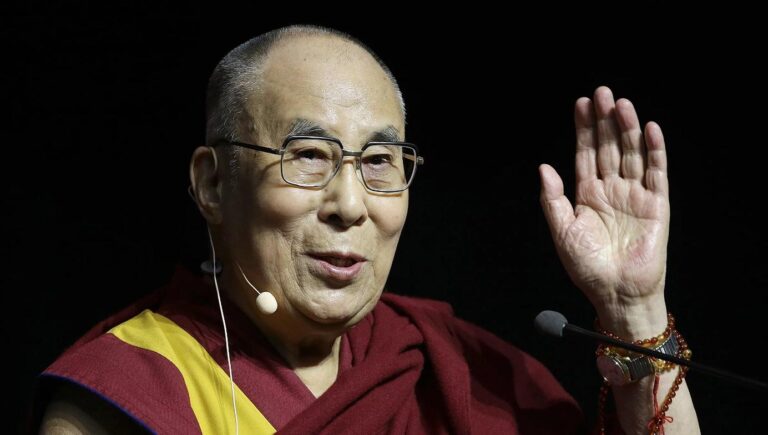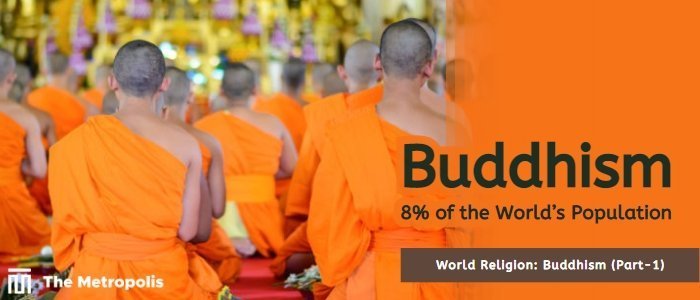Anjum Anam –
Buddhism is a religion and philosophy that developed from the teachings of the Buddha, a teacher who lived in northern India between the mid-6th and mid-4th centuries BCE (before the Common Era). Spreading from India to Central and Southeast Asia, China, Korea, and Japan, Buddhism has played a central role in the spiritual, cultural, and social life of Asia. From the beginning of the 20th century, it spread to the West as well.
The holy symbol of Buddhism is Ashoka Chakra because Buddhism spread from the initiation of Emperor Ashoka in Buddhist beliefs.
Basic Principle
The basic theme of Buddhism is to relieve from the cycle of “Death and Rebirth”, which is called “Nirvana”. If a person has Sorrow, it leads him/her to get affected by other earthly feelings (Lust, Anger, Greed, Infatuation, Drunkenness, And Covetousness), which are the causes of his/her actions.
If he/she gets his/her desired thing, he/she becomes happy. Otherwise stays in sorrow. After death, he/she stays in heaven for his/her good deeds or repents in hell for his/her bad deeds. Then again, he/she takes rebirth for his/her incomplete desire which keeps him/her in this cycle. This cycle continuously keeps him/her in this materialistic universe. But once he/she keeps himself/herself separate from earthly feelings and sorrow, then he/she gets Nirvana. The final freedom from the materialistic universe, and the cycle of “Death and Rebirth” leads the existence of a being towards non-existence.
Theravada or Southern Buddhism (36%)
Theravada is believed to be the oldest form of Buddhism. Even though the phrase is not used until much later, the Theravada tradition preserves the monastic way of life and adheres to the “Pali Canon”, which is the collection of the Buddha’s earliest surviving recorded sayings. In the 1st century CE, monks in Sri Lanka wrote down these ancient scriptures in the Pali language. Teachings had been passed down orally before this codification. Due to the increasing heterodoxy emerging in India, it was felt that original scriptures ought to be preserved. Later, it spread to Cambodia, Myanmar, Sri Lanka, Thailand, and Laos.
Mahayana or East Asian Buddhism (58%)
The Mahayana is a philosophical school that offered practitioners support in the form of sympathetic beings known as Bodhisattvas and preached the possibility of universal salvation. The intention was to make all sentient beings capable of attaining Buddhahood (becoming a Buddha). The Buddha was no longer viewed as just a historical figure but as a transcendent being to which everyone could aspire. Mahayana Buddhism is practiced all around Taiwan, China, Vietnam, Korea, and Japan.
Vajrayana or Northern Buddhism (6%)
Vajrayana emerged between 500 and 600 CE in India. The roots of Vajrayana Buddhism, an offshoot of Mahayana Buddhism, can also be found in prehistoric Hindu and Vedic traditions, including esoteric ritual literature intended to accomplish breakthroughs in the realms of the body, mind, and spirit. Some people claim that Vajrayana Buddhism provides a quick route to enlightenment.
Its practitioners were cloistered because some of its activities went against mainstream Buddhism and Hinduism by participating in actions that were ordinarily forbidden. The Dalai Lama served as an intimate mentor to initiates. Vajrayana Buddhism is practiced around Tibet and Mongolia.
Navayana Buddhism (Minority)
Another small sect of Buddhism is Navayana, which are lower caste converts from Dalits of India. In contrast to the Theravada, Mahayana, and Vajrayana branches of Buddhism that have been historically recognized, Navayana is regarded as a newer school of Buddhism. The Four Noble Truths, which are regarded as the cornerstone of the Buddhist traditions, as well as monk and monastic life, karma, rebirth in the afterlife, and samsara are among the practices and precepts that are rejected by Navayana. It fundamentally reframes what Buddhism is and updates the original Buddha teaching to emphasize social inequality and class conflict.
Buddhism in Geographical Map
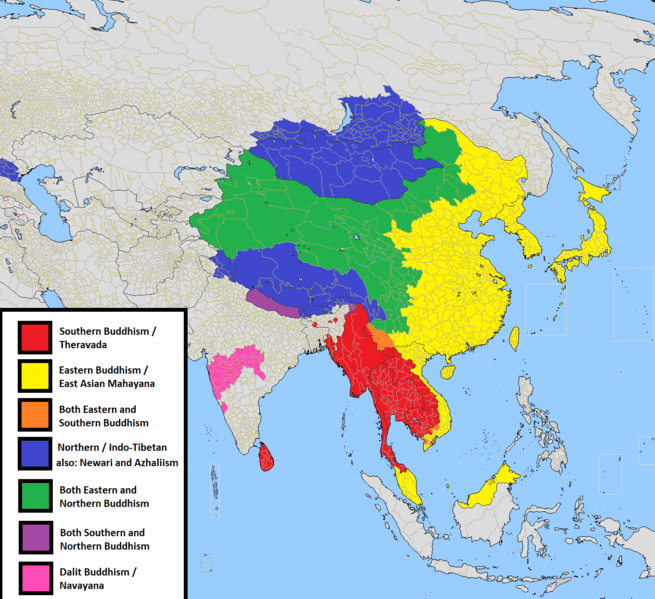
Spread of Buddhism
Early Spread in India:
The Buddha, also known as Siddhartha Gautama developed Buddhism in India during the 5th century BCE. The Buddha founded the Sangha, a group of monks and lay followers, after becoming enlightened and starting to share his knowledge with others. The Dharma, or teachings of the Buddha, initially took hold slowly in India, mostly among the lowest castes.
But over time, particularly under Emperor Ashoka in the 3rd century BCE, Buddhism grew in popularity and expanded across all of India. Ashoka turned to Buddhism after seeing the hardship brought on by his victories. Building monasteries and pillars with Buddhist teachings carved on them, he promoted the growth of Buddhism across his empire and assisted in spreading it throughout India.
Spread to Southeast Asia:
During the 3rd century BCE, traders and travelers took Buddhism to other parts of Asia. The Silk Road, a network of commercial routes connecting China, Central Asia, and the Mediterranean area, helped Buddhism gain popularity.
With the introduction of Theravada Buddhism to Sri Lanka in the third century BCE, Buddhism started to spread throughout Southeast Asia. The faith then extended to Cambodia, Laos, Thailand, and Myanmar (Burma), among other nations in Southeast Asia.
Spread to China:
The Han Dynasty brought Buddhism to China in the 1st century CE, but it was not until the 4th and 5th centuries CE, when monks and academics started to translate Buddhist scriptures into Chinese, that it was widely accepted. The Silk Road and the patronage of Chinese emperors, who regarded Buddhism as a way to solidify their control and foster social harmony, helped Buddhism spread throughout China.
Spread to Korea and Japan:
The 4th century CE saw the arrival of Buddhism in Korea from China, and as it slowly swept the land, it had a significant impact on Korean culture. Later it arrived in Japan from Korea in the 6th century CE.
The Spread to Tibet:
Vajrayana Buddhism, commonly referred to as Tibetan Buddhism originated in Tibet’s Himalayan region and its surrounding areas. The indigenous Bon religion, as well as Indian Buddhism and Chinese Taoism, had an impact on the faith. In the 7th century CE, Buddhism was first introduced to Tibet, where it spread and eventually took over as the main religion. Complex rituals, esoteric practices, and a focus on the guru-disciple connection are characteristics of Tibetan Buddhism. Millions of people practice Tibetan Buddhism now, and it has grown significantly in popularity in the West.
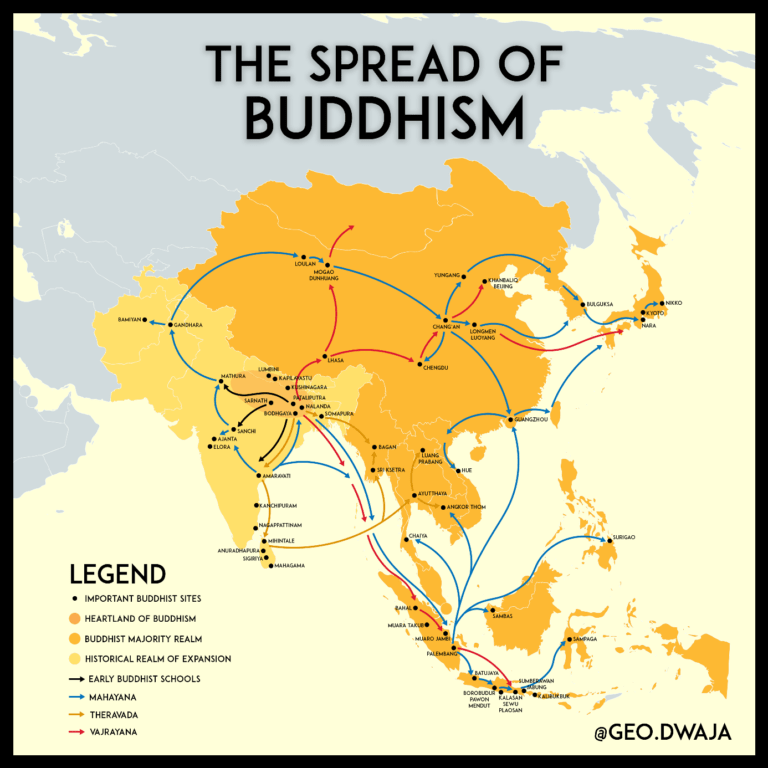
Holy Scripture
The traditional name for old collections of Buddhist holy texts is Tripitaka, also known as Tipiaka, which translates to “Triple Basket”. Some of the most significant Tripitaka in the modern Buddhist world are those upheld by the Theravada tradition in Southeast Asia, the Chinese Buddhist Canon upheld by the East Asian Buddhist tradition, and the Tibetan Buddhist Canon upheld by the Tibetan Buddhist tradition.
Written in Pali, parts of Tripitaka are –
-
Vinaya Pitaka (The Discipline)
-
Sutra Pitaka (The Teachings)
-
Abhidhamma Pitaka (The Philosophy)
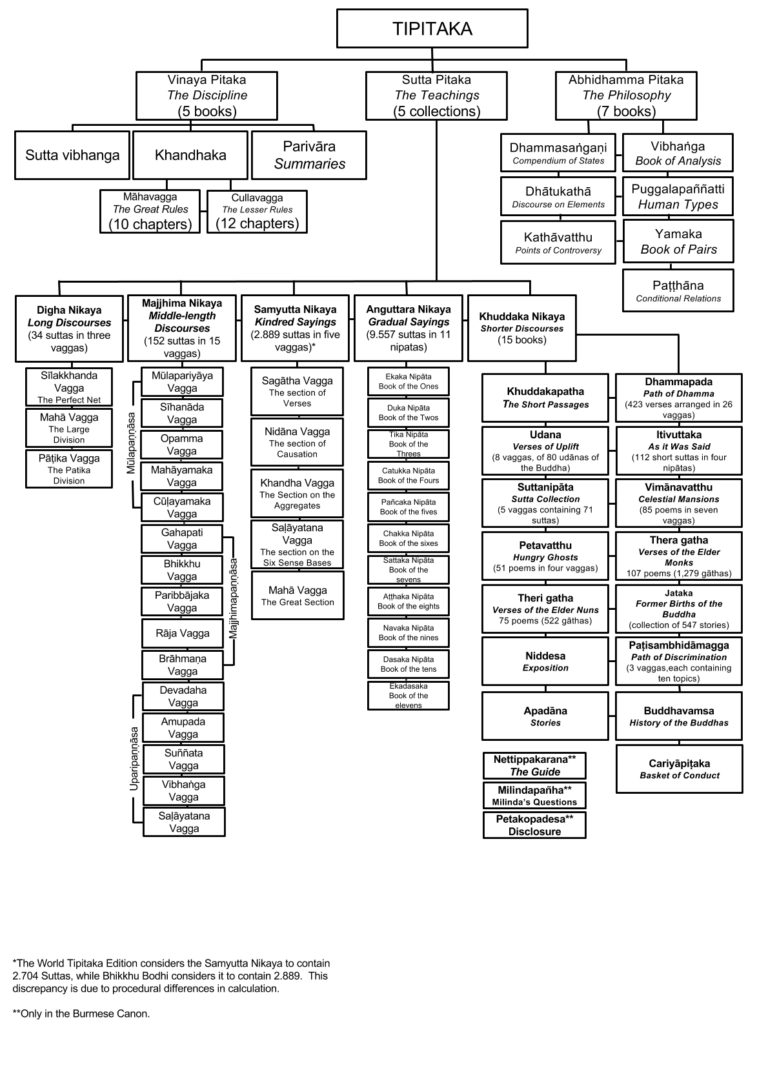
Holy Symbols
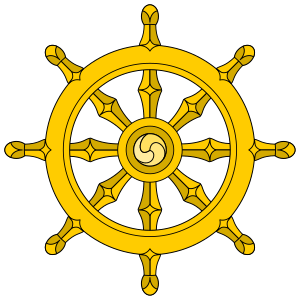
The Dharma Wheel (Dharmachakra) was originally an Indian symbol of sovereignty, power, and protection. The three primary components of a wheel are the hub, spokes, and rim. They stand for wisdom, focus, ethics, and wisdom. Buddha’s eight-spoked dharma wheel symbolizes the elements of the Noble Eightfold Path. These methods are supposed to aid in breaking the cycle of rebirth. In certain early Buddhist places, the wheel served as the Buddha’s emblem.
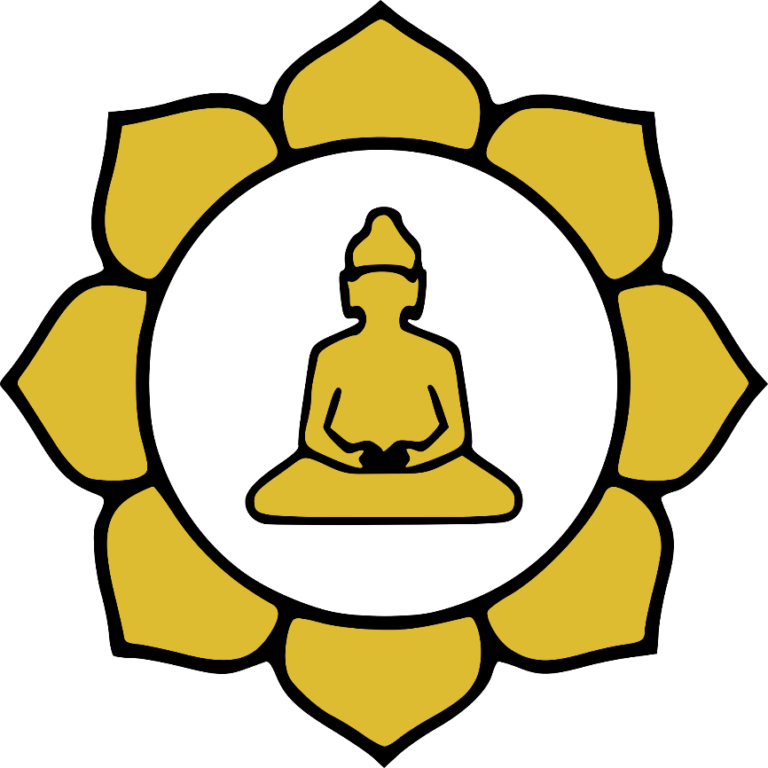
Lotus is a symbol of Buddhism for renunciation and purity due to its capacity of maintaining purity despite being around pollution and grime. It is a symbol of both birth and the divine beginnings of deities. In architecture, the lotus shape represents the Buddha’s presence and purity. Additionally, it is linked to Padmasambhava, who is credited with bringing Buddhism to Tibet.
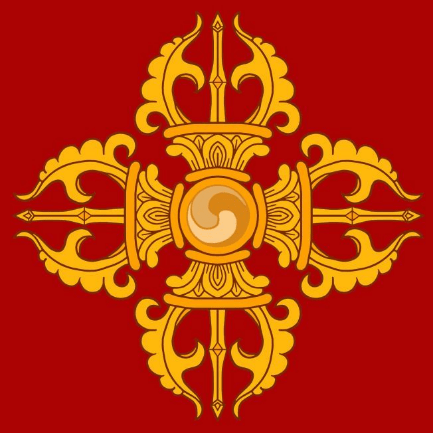
Vajra is a form of combat club used to represent the qualities of both a vajra (indestructibility) and a thunderbolt (an irresistible force). It features four prongs at either end that form a lotus-bud shape and is made of bronze or brass. These can be sharp points that serve as symbols of peace or can be made into lethal weapons. The vajra is utilized in both Chinese and Tibetan Buddhism. In Tibetan Buddhism, it is virtually usually utilized during rituals along with a bell.
Buddhist Monastery or Pagoda
Theravada Pagoda:
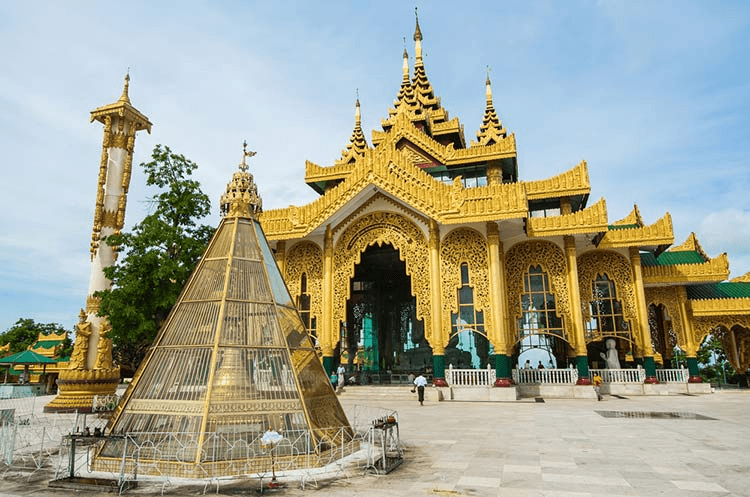
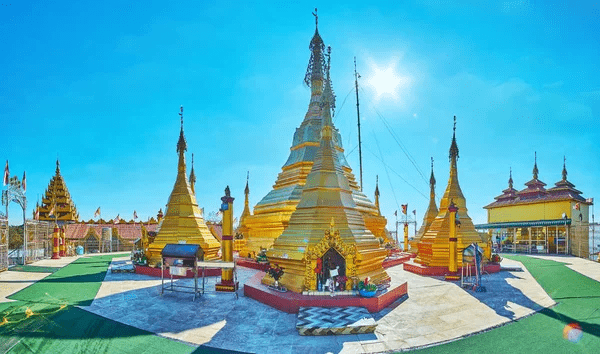
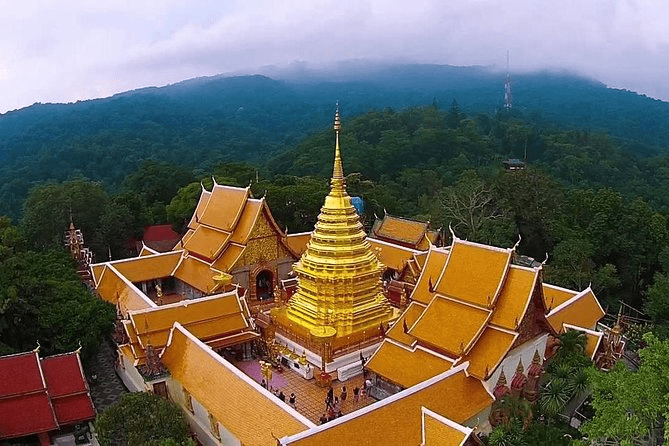
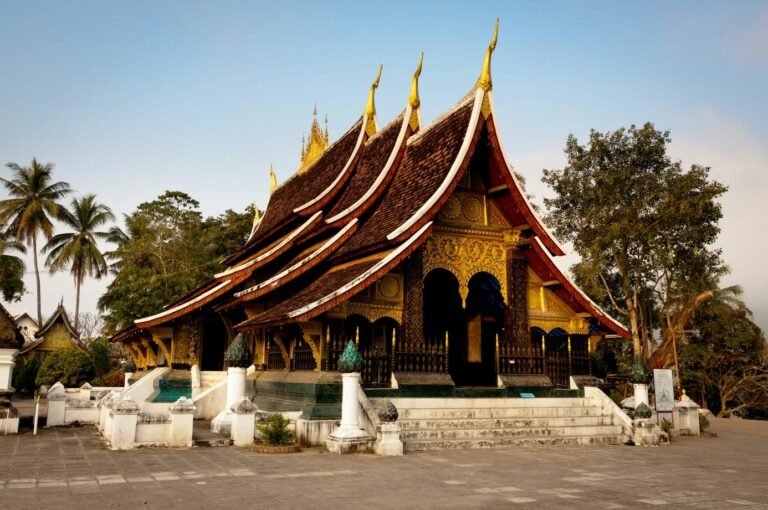
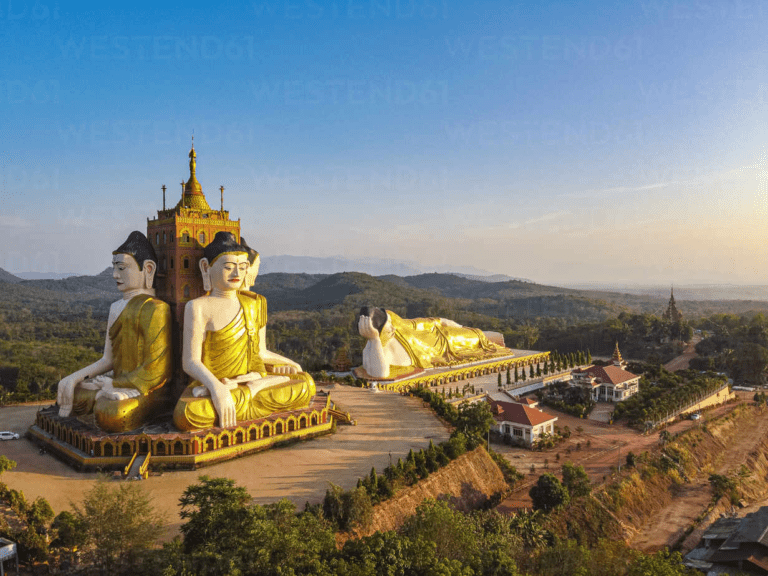
Mahayana Pagoda:
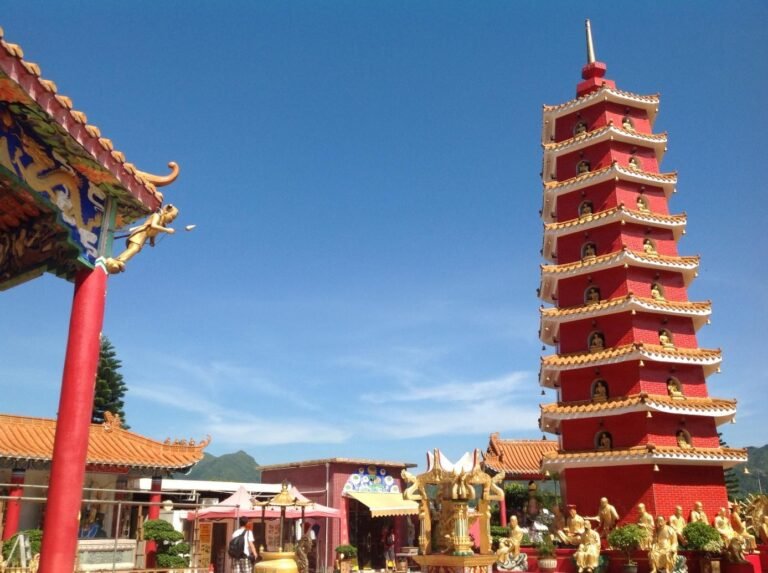
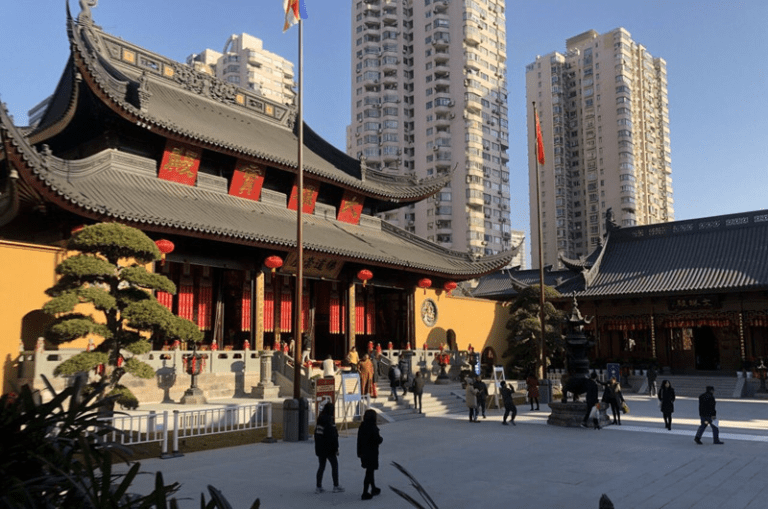
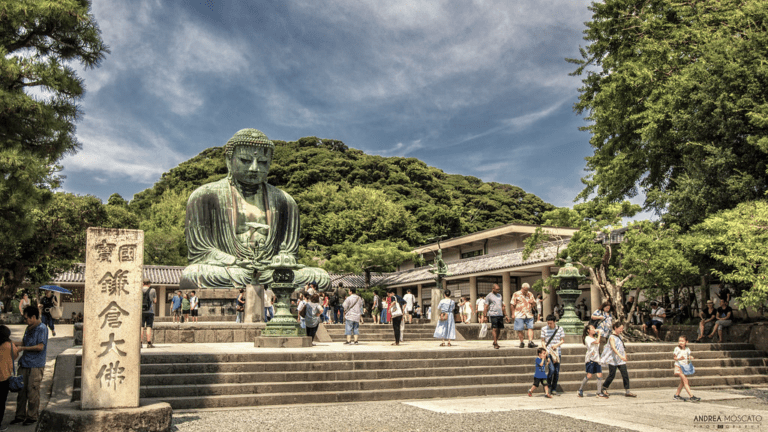
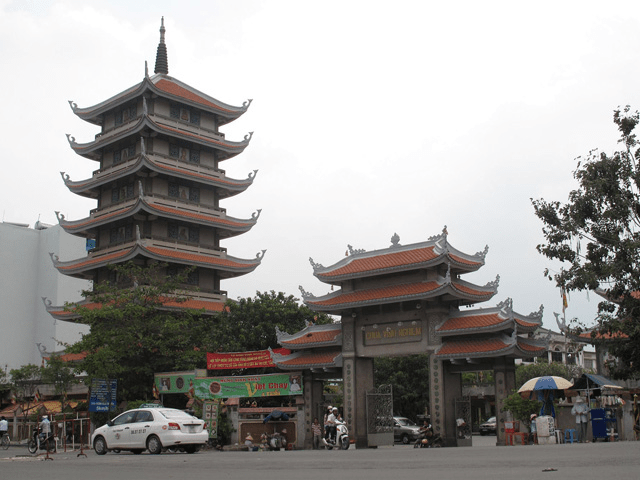
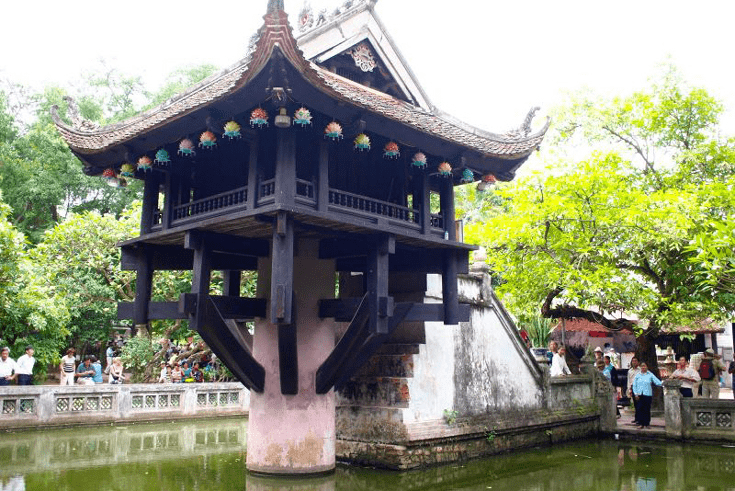
Vajrayana Buddhism Pagoda:
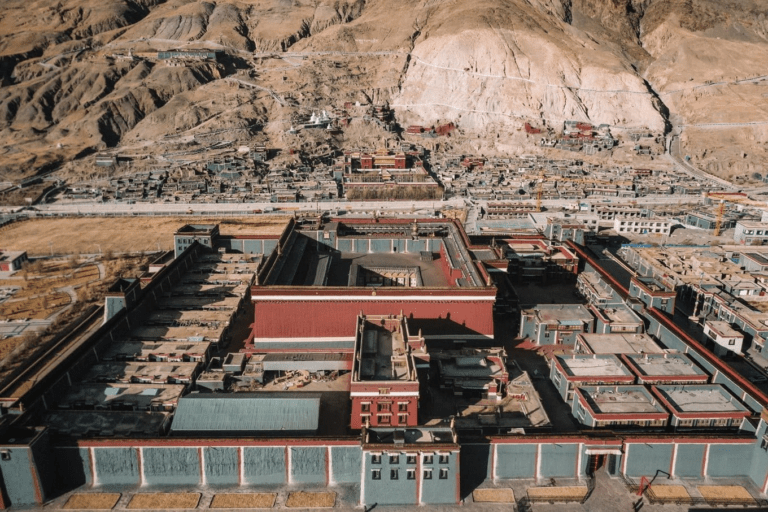
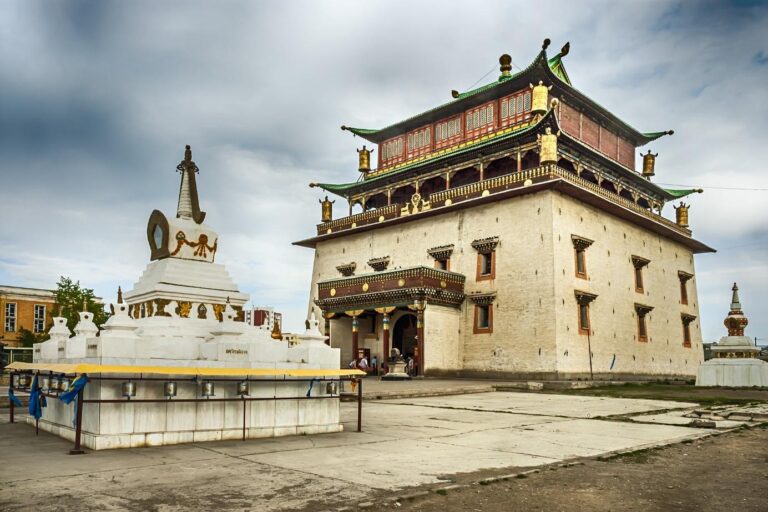
Buddhist Pilgrimage
- Lumbini is located in Nepal. It is the birthplace of Prince Siddhartha/ Gautama Buddha.
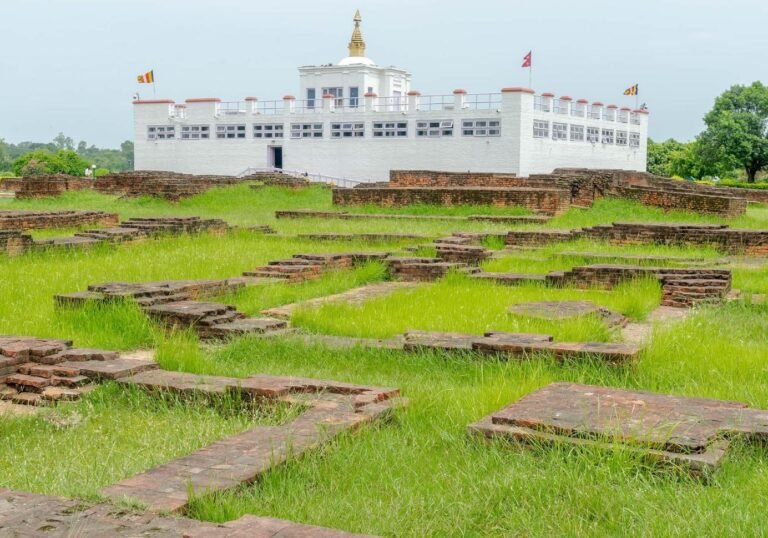
- Bodh Gaya is located in Bihar, India. It is the most important religious site and place of pilgrimage. It houses The Mahabodhi Temple which is believed to be the Bodhi Tree where Prince Siddhartha attained enlightenment (Nibbana) and became known as Gautama Buddha.
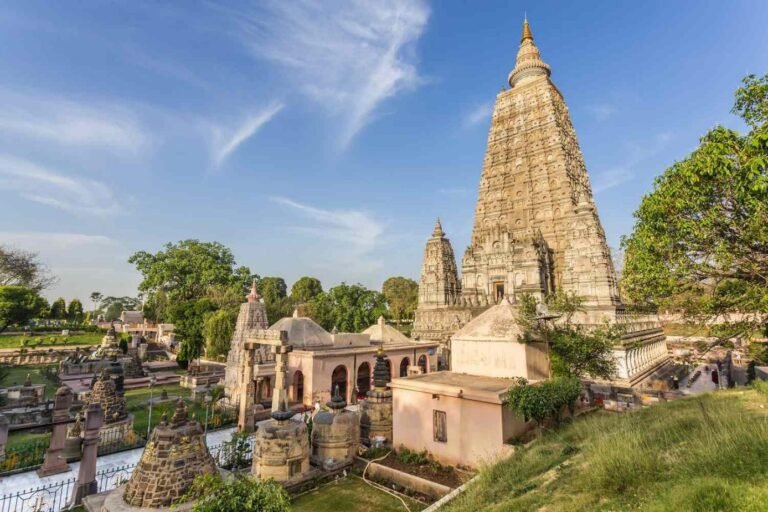
- Sarnath is located in Uttar Pradesh, India. Here Gautama Buddha delivered his first sermon and taught about the Middle Way, the Four Noble Truths, and Noble Eightfold Path.
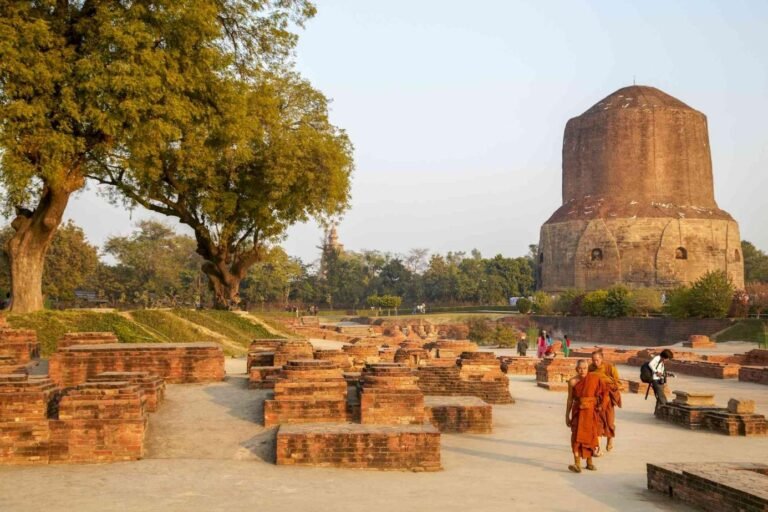
- Kushinagar is located in Uttar Pradesh, India. Gautama Buddha died and attained Parinirvana here.
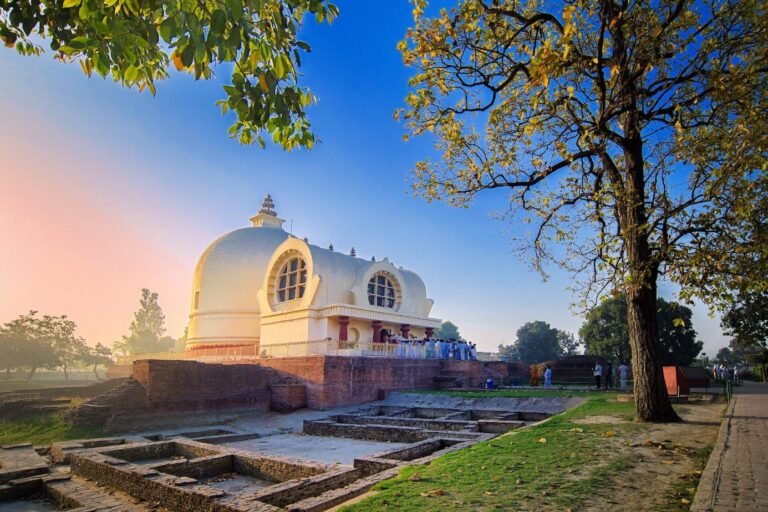
Festivals
Theravada Buddhism:
-
Vesaka/ Buddhist Purnima – Buddha’s birth, enlightenment, and death (May)
-
Dharmachakra – First education (July)
-
Difficulty/ Pravarana Purnima – Pilgrimage to the Pagoda (October)
-
New Year – In April
Mahayana Buddhism:
-
Nehan-e – Death of Buddha (February)
-
Higan-e – Realizing the transience of Earth’s life (March and September)
-
Hanamatsuri – Buddha’s birthday (April)
-
Jodo-e – Buddha’s enlightenment (December)
-
New Year – In January
Vajrayana Buddhism:
-
Cho Trul Druchen – Demonstration of miraculous powers (March)
-
Saka Dawa – Buddha’s birth, enlightenment, and death (June)
-
Cho Khor Duchen – First education (July)
-
Laha Bab Duchen – Divine teachings (November)
-
New Year – In February
Also, there are Parinirvana Day, Maghi Puja/ Purnima, Ashala Puja, Uposatha, Abhidhamma Day, Loy Kratong, Honey Full Moon, Plowing Festival, Elephant Festival, Tooth Festival, Avaloitesvara’s Birthday, Insatiable Soul Festival/ Ulambana.
Buddhist Monk/Bhikkhu
Buddhist monasticism is one of the main institutions of Buddhism and one of the earliest surviving types of structured monasticism. Bhikkhu (bhikshu) and bhikkhuni (bhikshuni), monks and nuns, are in charge of safeguarding and disseminating the Buddha’s teaching and assisting lay Buddhists. Theravada (Sri Lanka and Southeast Asia), Dharmaguptaka (East Asia), and Mulasarvastivada (Tibet and the Himalayan region) are the 3 remaining traditions of monastic discipline (Vinaya), which govern contemporary monastic life in each of these regional traditions.
Dalai Lama
It is a title given by the Tibetan people to the foremost spiritual leader of Tibetan/ Vajrayana Buddhism. He plays a similar role as the Pope of Catholic Christianity.
